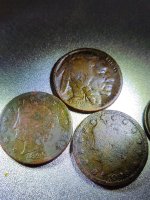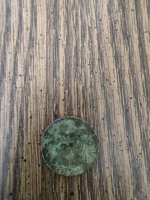kenb
Bronze Member
Digging Deadwood: Understanding Chinatown
New Archaeological Insight
By Shawn Werner
CREDIT: Adams Museum
The Black Hills are littered with ghost towns, crumbling testaments to a source of wealth that all too soon ran dry. Gold mining brought people to Deadwood and Lead, but even the richest mines eventually become depleted. Without another economic handhold, many towns that were prosperous during gold rush days are no longer even dots on the map.
Though their days as mining boom towns have passed, Deadwood and its sister city Lead continue to thrive thanks to nuggets of a less tangible variety. People still come to Deadwood in droves to soak up the rich, vibrant history and to wager a few bucks in the local casinos. Lead will soon be home to a state-of-the-art science laboratory. History, science and gambling are all intangible assets which will never dry up.
Without Deadwood’s history of gaming, which is as old as the town itself, it would have been a hard sell to legalize the pastime in 1989. Deadwood’s last “renewable resource” was halted by federal agents in 1905, leaving the town in danger of becoming another tumbleweed pasture. Thanks to a campaign by the progressive YouBet! Committee, capitalizing on the significance of gambling in Deadwood’s history, Deadwood became the third city in America to legalize gaming. In turn, gaming provides funding for the city’s historic preservation, one of the largest ongoing historic preservation projects in the United States.
The Adams Museum’s Digging Deadwood: Understanding Chinatown exhibit is the most recent example of success within the historic preservation project. From 2001 to 2003, an archaeological team headed by Rose Estep Fosha painstakingly recovered a plethora of artifacts from an excavation on lower Main Street, the historic location of Deadwood’s Chinatown. The artifacts were compiled into the compelling Digging Deadwood exhibit which gives new insight into the daily lives of Deadwood’s earliest Chinese residents.
In a lecture preceding the formal dedication, Fosha remarked, “I was so happy when I heard the Adams Museum was doing an exhibit on archeology. It’s something that needs to be done. Archeology needs to be done.” The years Fosha and her team spent culling priceless artifacts from the ground were not only a labor of love, they were an investment into Deadwood’s status as a national historic landmark. “If we didn’t do archeology, all we would have to show [for what was once a historic site] is a private parking lot.”
Discovery of the site, the first step in any archaeological excavation, happened through coincidence. While construction crews were working, a local archaeologist walking by the site noticed some artifacts in the freshly turned ground. After contacting local officials, the State Archaeological Research Center stepped in and soon after had a crew on site, recovering the multitude of artifacts interred there.
Those artifacts are now available for everyone to see at the Adams Museum. The Digging Deadwood exhibit offers a multitude of displays to engage visitors. One hands-on display invites guests to experience the different textures of masonry and other architectural materials that were used in many of Chinatown’s buildings. Another display highlights the cultural differences that existed between the predominately white residents of Deadwood and those of Chinatown.
Beatrice and Edith Wong, granddaughter and great-granddaughter of Fee Lee Wong, expressed their gratitude to both the Adams Museum and Deadwood for their continued efforts to educate people about the town’s culturally diverse heritage.
kenb
New Archaeological Insight
By Shawn Werner
CREDIT: Adams Museum
The Black Hills are littered with ghost towns, crumbling testaments to a source of wealth that all too soon ran dry. Gold mining brought people to Deadwood and Lead, but even the richest mines eventually become depleted. Without another economic handhold, many towns that were prosperous during gold rush days are no longer even dots on the map.
Though their days as mining boom towns have passed, Deadwood and its sister city Lead continue to thrive thanks to nuggets of a less tangible variety. People still come to Deadwood in droves to soak up the rich, vibrant history and to wager a few bucks in the local casinos. Lead will soon be home to a state-of-the-art science laboratory. History, science and gambling are all intangible assets which will never dry up.
Without Deadwood’s history of gaming, which is as old as the town itself, it would have been a hard sell to legalize the pastime in 1989. Deadwood’s last “renewable resource” was halted by federal agents in 1905, leaving the town in danger of becoming another tumbleweed pasture. Thanks to a campaign by the progressive YouBet! Committee, capitalizing on the significance of gambling in Deadwood’s history, Deadwood became the third city in America to legalize gaming. In turn, gaming provides funding for the city’s historic preservation, one of the largest ongoing historic preservation projects in the United States.
The Adams Museum’s Digging Deadwood: Understanding Chinatown exhibit is the most recent example of success within the historic preservation project. From 2001 to 2003, an archaeological team headed by Rose Estep Fosha painstakingly recovered a plethora of artifacts from an excavation on lower Main Street, the historic location of Deadwood’s Chinatown. The artifacts were compiled into the compelling Digging Deadwood exhibit which gives new insight into the daily lives of Deadwood’s earliest Chinese residents.
In a lecture preceding the formal dedication, Fosha remarked, “I was so happy when I heard the Adams Museum was doing an exhibit on archeology. It’s something that needs to be done. Archeology needs to be done.” The years Fosha and her team spent culling priceless artifacts from the ground were not only a labor of love, they were an investment into Deadwood’s status as a national historic landmark. “If we didn’t do archeology, all we would have to show [for what was once a historic site] is a private parking lot.”
Discovery of the site, the first step in any archaeological excavation, happened through coincidence. While construction crews were working, a local archaeologist walking by the site noticed some artifacts in the freshly turned ground. After contacting local officials, the State Archaeological Research Center stepped in and soon after had a crew on site, recovering the multitude of artifacts interred there.
Those artifacts are now available for everyone to see at the Adams Museum. The Digging Deadwood exhibit offers a multitude of displays to engage visitors. One hands-on display invites guests to experience the different textures of masonry and other architectural materials that were used in many of Chinatown’s buildings. Another display highlights the cultural differences that existed between the predominately white residents of Deadwood and those of Chinatown.
Beatrice and Edith Wong, granddaughter and great-granddaughter of Fee Lee Wong, expressed their gratitude to both the Adams Museum and Deadwood for their continued efforts to educate people about the town’s culturally diverse heritage.
kenb




